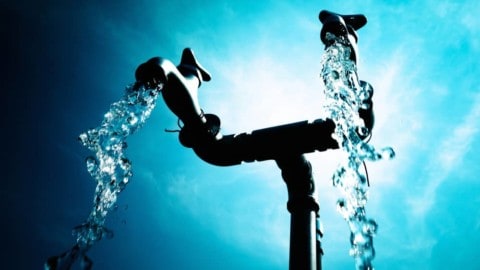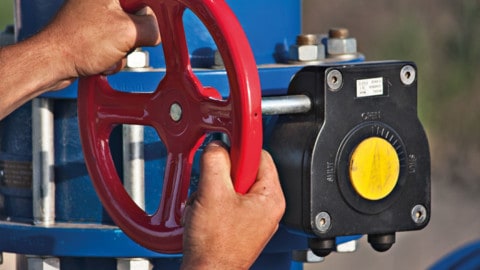A geothermal installation at Fairwater – a major residential community in Sydney by Frasers Property Australia – is one of the largest of its kind in the southern hemisphere, using heat pumps and ground loops to provide heating and cooling to 750 homes. The innovative solution was part of a $1.71 million, three-year study known as the Fairwater Living Laboratory that examined the effects of ground source heat pumps (GSHPs) on energy costs for residents and investigated its viability for industry-wide adoption of the technology as part of local, renewable and efficient energy infrastructure.
Fairwater is a 38ha residential development located 1km from Blacktown in Western Sydney, with over 2,000 residents. Developed by Frasers Property Australia, it has been designed for sustainability.
With more than 800 homes in Fairwater incorporating geothermal – GSHPs – for HVAC, it is the first large-scale residential development to use it in Australia and is one of the largest installations in this application in the southern hemisphere.
The use of this technology also helps to make it one of the most environmentally friendly residential developments in the country and the first project in the state to achieve the highest recognition from the Green Building Council of Australia – a six star Green Star – Communities rating. It is one of only a handful of projects nationally to receive this rating.
The geothermal installation was used for the Fairwater Living Laboratory – a study funded by the Australian Renewable Energy Agency (ARENA), Frasers Property Australia, and the New South Wales Office of Energy and Climate Change.
The three-year study was undertaken at the development between September 2019 to August 2021 by Climate-KIC Australia and carried out by researchers from University of Technology Sydney and Curtin University, with the findings now being used to inform government policy and encourage broader industry adoption of the efficient energy geothermal infrastructure.
A sustainable solution
Geothermal has been used in applications for many decades in North America and Europe as a highly efficient and reliable source of heating and cooling, helping to reduce dependence on fossil fuels. Until the Fairwater project, most geothermal applications in Australia were single dwelling, small commercial applications and pool heating.
Nicholle Sparkes, General Manager, Delivery and Operations, Frasers Property Australia, said the company is always looking at opportunities to invest in smart sustainable technology that benefits its customers and the environment. This led to the choice to install geothermal.
“The decision was made as part of our initiative to develop and lead by example to ensure we looked at emerging technologies and to drive sustainable outcomes in our communities,” Ms Sparkes said, “Geothermal was selected due to its ESG advantages, with a proportion of energy sourced from the ground, ensuring it’s a renewable energy outcome and helping us reduce our carbon footprint.
“Another advantage is the ability to roll it out in a scalable area to provide an affordable heating and cooling outcome for customers.”
The geothermal systems in Fairwater are able to deliver over 14,000kW of heating and cooling, with a Coefficient of Performance (COP) approximately double that of conventional air conditioners.
The key difference between geothermal and conventional HVAC systems is that geothermal uses the ground as a heat source in winter and as a heat sink in summer. On the other hand, normal air conditioning systems have a condenser sitting outside the home, which has a coil that refrigerant runs through and a fan sitting behind the coil to disperse air across it.
This means in summer it’s using the outside air to reject heat from the condenser coil, and in winter it’s using outside air to collect heat.
This difference is important as air temperatures vary not only on a seasonal basis, but also on a daily basis, whereas ground temperature is constant. So regardless of what the outside air temperature’s doing, it will always be 22-23˚C below the ground.
Another benefit of geothermal over conventional HVAC is the design and amenity of the equipment. The GSMI heat pumps provided by Alinta Energy for the project are smaller and quieter than normal air conditioning condensers, so they don’t have the same noise and airflow issues associated with conventional systems.
This becomes more beneficial as housing lots get smaller or, like many houses at Fairwater, when there is no backyard. This is important for design and amenity outcomes as having an air conditioning condenser sitting in an al fresco area makes that area unusable when the system’s running. With the geothermal system, it operates much quieter, and doesn’t disperse air into that space.

How does geothermal work?
The heat pumps used at Fairwater work similar to a conventional air conditioning system, with one major difference – the condenser coil is in the ground in the geothermal loop rather than sitting beside it.
In cooling mode, the heat pump circulates a hot refrigerant gas through the geothermal loops in the ground so that it can absorb the cooler temperatures found below the earth before becoming a liquid. It then gets sent to the heat pump where the pressure is lowered so it cools further before it is circulated through the fan coil unit in the home to absorb the heat in the air and cool the house.
In heating mode, a cool refrigerant is circulated through the geothermal loops to absorb the heat from the ground. It is then compressed and circulated through the fan coil unit to provide heating. In both modes, after the refrigerant has re-heated (cooling mode) or cooled (heating mode), the cycle repeats itself.
Ground source heat pumps for the Australian market
The heat pump for the Fairwater development was provided by Alinta Energy – the GeoAir system. Measuring just 600mm by 600mm and standing 890mm high, it has no external fan or condenser coil, and the units operate at 51dB.
It was developed and designed specifically for Australian conditions and to be similar to a conventional system so that the developer’s existing air conditioning contractors could be retained to provide installation. As it’s compact and quiet, it is also easily integrated into any design, meaning there are no visible or perceptible differences to occupants compared to conventional systems, and it is well received and deployed by occupants.
Ms Sparkes said the geothermal system installed at Fairwater consists of three main components: the loop, the heat pump, and the fan coil unit. The geothermal loops are installed by a drilling rig vertically adjacent to each home to a depth of around 80m. The system then connects to a typical ducted air conditioning system that can be installed by air conditioning trade contractors.
Once in operation, the system works much like the standard reverse-cycle air conditioners, but with much greater efficiency and fewer moving parts, meaning it also requires less maintenance.
“The above ground air conditioning system is serviced in the same way a standard unit is serviced, which is generally on a yearly basis to ensure everything is running correctly and any filters are cleaned and or changed to ensure the best air quality is circulated around the home to maintain comfort levels,” Ms Sparkes said.
Challenges of geothermal
Installing geothermal systems at a larger scale, such as for Fairwater, needs close coordination and planning before building even commences. In a normal build process, air conditioning installation is one of the last things that is done, but for geothermal systems it needs to be one of the first things completed on site.
The process requires the development application drawings to have the location where the geothermal loop has to go. The developer can then do the bulk of earthworks and survey the location as per the drawings where the geothermal loop is to be installed. A specialised installation process was developed in partnership with Frasers to integrate within the company’s existing processes.
This included:
- Locating the position of the heat pump on the DA drawings
- Ensuring the surveyor on site would mark the location of the heat pump immediately following bulk earthworks
- Approval for works received from New South Wales Water
- Geothermal loop installed at the nominated location before any other works began
- The geothermal loops are capped and protected with building works following to program
Installing the geothermal system
The geothermal loop was the first part of the system to be installed at Fairwater using specialist drilling equipment. The loops were installed at 200mm off slab and the heat pumps were placed adjacent for connection.
To install the loops, a 125mm diameter hole is drilled into the ground at a depth that is dictated by the system size, with larger systems requiring the hole to be deeper to ensure there is enough surface in the ground for heat rejection.
Once the hole is completed, the geothermal loop is installed in the ground using gravity feed and a thermal conductive grout is injected around it. The grout has two purposes:
- Thermal conductivity –air is an insulator, so if the loop is suspended in a hole, heat will not be transferred
between the geothermal loop and the subsurface material - Environmental – cementless grout is used to plug the hole and prevent any cross-aquifer interference. It also prevents surface water contamination of groundwater
Once the loops have been installed, the house can be built and the normal air conditioning installation process follows including installation of the fan coil unit and ductwork. The geothermal heat pump is then installed once the house is finished and landscaping is done.

Positive findings for use of geothermal in the future
Findings from the study have been positive. The study found that when installed at scale, and at the beginning of the building process, geothermal can be both a profitable and environmentally beneficial addition to a home despite the additional upfront cost to construction.
The GSHPs added value to houses, and reduced power consumption by 21 per cent on average, as compared to nearby homes without the technology. Cameron Jackson, General Manager Development New South Wales, Frasers Property Australia, said the company has an ambitious target of being net zero in development and operation by 2028, and that means investigating new technology and spending the time to analyse and evaluate it.
“This has been such an interesting project to support, and watch unfold,” Mr Jackson said. “We were confident the installation of geothermal heating and cooling technology in our Fairwater homes would help our customers reduce their energy consumption, and their bills, and now we have confirmation of that.
“We will use the findings of this ground-breaking study to guide us on our pathway to net zero.”
The project also encompassed the Sydney COVID-19 lockdowns, finding that the demand reduction aspects of the geothermal technology had the potential to ‘smooth out’ electricity grid usage, which could help avoid spikes that can lead to blackouts and power cuts in extreme weather.
Fairwater homes recorded an average of 3kW of avoided power demand per household during critical peak events.
Professor Leena Thomas, Research Project Lead, University of Technology Sydney, said, “A major benefit of geothermal air conditioning beyond energy savings for individual home owners is its benefits to electricity grid networks to reduce the peak demand.
“Our statistical modelling of smart meter data indicates that for every degree that outdoor air temperature moves away from the comfortable range, demand from conventional air conditioning (heating and cooling) increases by between six and eleven per cent in hot weather and between 3.5 per cent and nine per cent in cold weather.
“On the other hand, geothermal air conditioning reduces this rate to between 4.5 per cent and nine per cent for hot weather and between two per cent and six per cent for cold weather. Due to the compounding nature of these rates, savings rapidly increase in terms of electrical kilowatts when temperatures are extreme, but also differ depending on time of day.
“When used at scale, depending on location within the network, this could play a role in deferral of network augmentation.
“These benefits are all the more relevant in current scenarios of warming temperatures, increasing housing demand and urbanisation in Western Sydney and other locations around Australia.”
As well as offering a number of insights in relation to environmental performance, the results also provided insight into occupant behaviour and experience.
“It is pleasing to see that the research demonstrated clear energy benefits from geothermal technology and high ratings for comfort in the Fairwater homes,” Prof Thomas said.

“An overwhelming majority of residents at Fairwater also reported that living in the precinct has had a positive effect on their health and wellbeing.
“Our findings highlight that an integrated precinct-based approach for incorporating sustainability and energy efficient technologies when combined with an understanding of occupant practices offers the best pathway for decarbonisation and getting beyond net zero.”
User behaviour and occupant preference is important as it plays a key role in the actual performance and savings that can be realised when installing new technology such as GSHP.
The results found:
- Residents would benefit from a targeted program of user engagement and education
- Engaging with residents and consumers is a critical way for industry and regulatory bodies to gain feedback and insights in relation to interventions (such as GSHP) that are implemented
“It is commendable that the developers were actually interested to gain feedback of the performance in practice and engage in knowledge sharing – this is not always how the building industry operates,” Prof Thomas said.
The results from the study provide tangible evidence on the performance in practice of geothermal air conditioning and actionable insights for various stakeholders.
They have been widely disseminated through ARENA knowledge sharing deliverables. Belinda Whelan, Director of Strategic Projects, Climate-KIC Australia, said the study provides governments and the property industry with solid information on which to base their geothermal decision-making.
“The built environment sector in Australia has a really important role to play in helping Australia meet its net zero ambitions. Studies like Fairwater provide policymakers and the property sector with deep insight and data to guide informed decision-making to make rapid change at scale,” Ms Whelan said.
In addition to communicating the results to ARENA, Frasers Property’s design and development team, and Fairwater residents, special briefings have also been conducted for policymakers at New South Wales Government Department of Planning and Environment, Office of the Government Architect NSW, as well as through forums for property and design professionals (Green Building Council of Australia’s Transform, Parlour Lab, etc.) and for the electricity network.
While there are no immediate plans to undertake another study of this kind, Prof Thomas said that a full cost-benefit investigation, including the capital costs of systems, installation and maintenance, embodied energy or direct emissions (including global warming potential from possible refrigerant leakage) which was outside the scope of the present study should be considered as a next step when commissioning additional research.
“We also believe it would be useful to conduct more detailed comparisons between various system configurations such as geothermal refrigerant loops like the one included in this heat pump study, geothermal systems with water loops and standard heat pumps.
“More rigorous studies to investigate the wider application of geothermal should be considered beyond residential settings. Additionally, we are engaging with various stakeholders as to how the living laboratory approach can be replicated in other contexts.”


















Comments are closed.
It’s inspiring to see advancements like these being implemented, paving the way for a greener future. Kudos to the project team and all involved in making this groundbreaking initiative a reality!